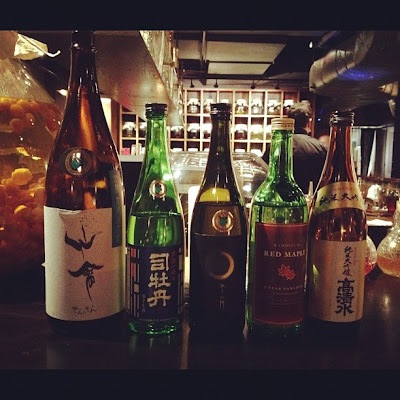There are stream of lives given birth to the world
while every organism still hibernates in deep winter.
It is the season’s firstly pressed Sake.
Some breweries start brewing Sake in the end of October,
and around December is when the first batches of the Sake are pressed.
It is called “Shinshu“ literally means “new sake“.
Most of the sake is pasteurized and aged from 6 months to 1 year after pressing
and it makes the flavor of sake mellow and round out.
Shinshu is sake released without pasteurization and its maturation.
And it has a extremely fresh and zingy flavours
you can only enjoy during the beginning of new year.
At Roka, we have received 4 different Shinshu Sake as a seasonal selection.
多くの生き物が眠る冬に、なによりも早く命を芽吹くものがあります。
それは、日本酒。
早い蔵だと10月から酒造りが始まり、
その年最初にできたお酒の絞りが12月ころから始まります。
この生まれたばかりのお酒は「新酒」と呼ばれ、
殆どの日本酒が加熱処理をしたあと半年〜1年程度熟成させるのに対し、
新酒は火入れも熟成も一切しないのが特徴。
びっくりするくらいフレッシュで若々しい味わいは、
年の初めのみ楽しめる季節のおくりものです。
今年は震災の影響ため日本と同じ時期に揃う新酒が少なく、
昨年の秋あがりや熟成生酒も含めた4種になってしまいましたが、
まだまだフレッシュ感を充分に味わって頂ける品揃えになっています。
1) Senkin, Ginjo Muroka Genshu / 仙禽 吟醸無濾過原酒
Origin: Tochigi
Rice: Hitogokochi
Rice polished ratio: 55%
AVB: 16%
Note:
Senkin Brewery is micro-brewery run by 2 young brothers. The concept of their sake flavor is “marriage of the higher sweetness and acidity”, “wooden barrel making”, “hanging-sack-filteration”, “not-using Yamadanishiki rice”, which makes their sake so special and unique.
Description
clean, soft and delicate sake with pleasant acidity. It will go well with wide range of food from sushi/sashimi to grilled dishes.
2) Tsukasa Botan, Honjozo Reika Nama / 司牡丹 本醸造零下生
Origin: Kochi
Rice: Yamadanishki, Koshihikari, Akitsuho
Polished ratio: Koji rice 65% & Kake rice 70%
AVB: 16.8%
Note:
Kochi prefecture on the south coast of Shikoku, historically called the Tosa region, has been synonymous with sake brewing since the 17th century. The name Tsukasabotan is inspired as follows: Botan translates as peony, sometimes called the king of flowers. Tsukasa denotes "chief" or "high office", thereby meaning the sake aims to be the very best of the best.
Description
Clean, crisp and refreshing mint on palate with beautiful aromas of sea breeze.
3) Fuyu no Tsuki, Junmai Ginjo Nama / 冬の月 純米吟醸生
Origin: Okayama
Rice: Nihionbare
Rice polished ratio: 58%
AVB: 16-17%
Note:
Okayama-prefecture, a famous peach producing area, and the birthplace of legend Momotaro (Peach boy), Kamikokoro brewery was founded in 1913. Kamikokoro brewery is a relatively young micro sake brewery.
Description:
This aromatic Sake is uniquely produced by using yeast from local white peaches. It has creamy and pungent nectarine flavors with lingering finish. This sake is great on its own, yet will bring up the flavors of highly spiced / seasoned dishes with Yuzu, garlic or truffles.
4) Kamoizumi “Red Maple”, 2year aged Nama Genshu
/ 賀茂泉「レッドメープル」二年熟成生原酒
Origin: Hiroshima
Rice: Hattannishiki
Rice polished ratio: 50%
AVB: 18.5%
Note:
The Maegaki family who run Kamoizumi committed to unfiltered Junmai production in 1971 when most of Japan insisted on charcoal filtering. Where most breweries saw impurities, Kamoizumi tasted complexities.
Description:
Un-pasuteurized, undiluted and aged 2 years below freezing brings rich and satisfying flavors of nuts and winter spices, Ribs and pork and teriyaki sauce would be great company to enjoy the depth of this sake.
The 5th Sake on the very right is the new product of my family company
listed on our regular Sake list:
そして一番右にある高清水の純米大吟醸は、
今季からレギュラー商品として取り扱いを始めた新商品:
Takashimizu, Junmai Daiginjo / 高清水 純米大吟醸
Origin: Akita
Rice polished ratio: 45%
AVB: 15.5%
Note:
Akita Shurui Seizo, producer of Takashimizu brand, is a joined force of Akita’s 12 small sake producers who got together back in 1944 in order to overcome the war-time shortage of ingredients. These breweries gave up their own brands which they inherited and took on the name Takashimizu, the name of the hill on which Akita castle had once stood upon.
Description
clean and creamy Daiginjo with freshness of honeydew melon.
Please come stop by!


0 comments:
Post a Comment